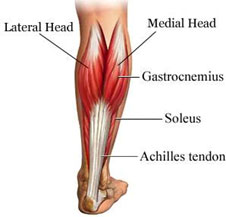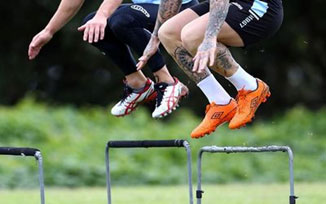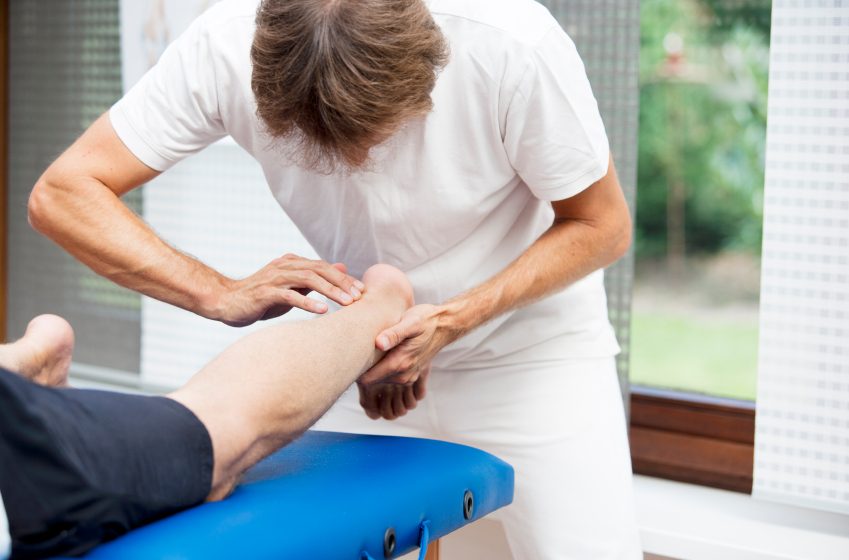If you are a soccer player, then you may have experienced pain or swelling in the back of your heel, over the thick cord-like structure, called your A
If you are a soccer player, then you may have experienced pain or swelling in the back of your heel, over the thick cord-like structure, called your Achilles Tendon. The Achilles Tendon is a dense tissue that connects the calf muscles, or the gastrocnemius-soleus complex, to the heel bone, known as the calcaneus. When you rise up onto your toes, when you transfer your weight while running, and when you jump and land, your Achilles Tendon is involved in controlling the mechanics of the movement.

Tendonopathy occurs when a tendon is overloaded beyond its capacity and becomes painful, inflamed, or weakened. Injuries involving the Achilles Tendon range from acute inflammation/irritation of the tendon (tendonitis), to chronic irritation and degeneration (tendonosis), to calcification, to rupture or failure of the tendon fibers (can be a partial or complete tear).
The Achilles Tendon may become injured for various reasons, including weakness, lack of flexibility, altered mechanics or pronating feet, progressing training or activity too quickly, or changes in footwear or running form.

Prevention
The best way to prevent Achilles Tendonopathy is by strategically training to develop adequate strength and flexibility necessary for soccer-specific movements. Tendinous tissue is capable of adaptive change, meaning it will become stronger when placed under gradually increasing amounts of stress. However, the increase in stress cannot be too rapid, or the tendon will become overloaded. For example, initiating a running program on hard terrain or uphill, or increasing duration too quickly, can result in an overuse injury to the Achilles Tendon.
The calf muscles must have sufficient flexibility to allow the ankle and foot to move through full range of motion, otherwise increased tensile stress on the tendon could result in tissue failure. For example, imagine a soccer player jumps for a header, gets knocked off balance in mid-air, and lands on one foot, bending his knee and ankle to shock-absorb. The ankle is forced into extreme dorsiflexion, placing a stretch onto the calf and Achilles Tendon. Repeated occurrences, or a single traumatic episode, can both result in injury.

Another way to ensure that the Achilles Tendon is prepared for the soccer season is through plyometric exercise and eccentric loading. Plyometric exercises include quick loading and releasing of energy, as in jumping, hopping, and agility work. Eccentric loading is a strategy that strengthens the tissue while lengthening, which is important for shock-absorption and controlling motion at the rear-foot when landing. These sport-specific exercises help prepare the Achilles Tendon for the demands of sprinting, jumping, cutting, etc.
Finally, soccer players should always properly warm-up prior to training or games. Dynamic warm-up exercises, such as “double-leg squat-jumps in place” can be effective in warming up the Achilles Tendon and lowering the risk of injury. Ultimately, the better prepared the tissue is, the lower the risk of injury.

Rehabilitation
Should Achilles Tendon pain occur, rehabilitation strategies should be initiated immediately as the condition will likely worsen and be more difficult to alleviate. Here are some rehabilitation tips:
- Bracing, taping, or complete immobilization may be necessary to reduce the amount of stress on the tissue and allow proper healing to begin.
- Cold packs (15-20 min) or ice massage (5 min) can help reduce swelling in and around the Achilles tendon.
- If flexibility deficits have contributed to the irritation, a proper stretching program is necessary to reduce the stress on the Achilles Tendon. Stretching of both the gastrocnemius and soleus muscles is necessary to improve flexibility through the calf. Poor technique can result in over-stretching the bottom of the foot, rather than isolating the calf muscles as intended.
- Eccentric training. Eccentric loading programs (emphasizing deceleration or increased demand on the lowering phase of contraction) have been proven successful in several research studies.
- Proper footwear. If you have flat feet, or excessive pronation, then orthotics or heel-cups may be necessary to improve the mechanics at the mid and rear-foot, thereby reducing stress on the Achilles Tendon.
- Normalizing lower extremity mechanics by improving the strength of ankle stabilizing muscles, and improving strength at your hip and core, will improve lower extremity mechanics, potentially decreasing excessive load on the Achilles tendon. A skilled orthopedic Physical Therapist will be able to assess movement patterns and retrain proper mechanics.
We recommend that you see your physician if you suspect a severe injury, such as a rupture of the Achilles Tendon, as surgery may be indicated. Consult with your Physical Therapist to find out the most important contributing factors and get a personalized treatment plan to get back to soccer as quickly as possible.
If you are currently experiencing Achilles Tendon pain and live in the San Diego area, contact me for a consultation and find out how we can help speed up your recovery.
